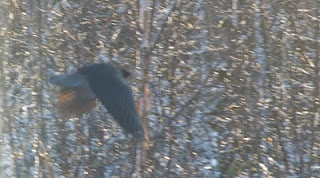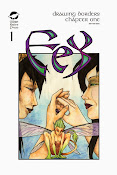
I've been meaning to post more about the house, but somehow other things kept taking precedence. Today was such a good day for avian neighbours, though, that I was finally prompted to blog.

With the exception of bald eagles and ravens, who tend to fly overhead but not stop in, I saw every kind of bird today that I had seen at the the house so far, plus a couple of new visitors.

We have two suet feeders, which are frequented by black-capped chickadees, bluejays and downy woodpeckers. We've had large flocks of chickadees, who are entirely fearless and cheerful little birds. I can't say how many have visited at once, because they don't stay still long enough to count. As for bluejays--who like both the suet and the loose seeds--we usually get five or six at a time, but I've seen as many as twelve flitting about the yard at once.

The downys tend to stop by singly, but there are at least two of them; we've spotted a male and a female (the males have a red spot on the back of their head). There is a flock of mourning doves who visit the loose seed (and who will even chase off the bluejays, if they get too obnoxious). The number varies, but I think there may be six or seven altogether.

There are also at least two crows who visit regularly, but unlike city birds, they're quite shy and keep their distance from the house. They fly into the trees if anyone goes outside, but I think they're beginning to figure out that a person outside often means tasty things to eat. One of them is a relatively small bird, and the other is so large I keep checking the shape of his (or her) tail to make sure it is actually a big crow, and not a small raven.

Today, I glanced out the window and saw--to my surprise and delight--that the black and white, red head-spotted woodpecker clinging to the nearest suet feeder was much larger than our usual downy visitors. It was a shyer bird, a hairy woodpecker. He sat and ate off one feeder while the little female downy had her lunch on the other. I ran upstairs to get my camera, but he flew off just as I was adjusting the focus (which is what also happened with the crow photo, except I managed to snap a poorly exposed pic of him flying away).
The other new visitors were three (or maybe more) tree sparrows. They look much like house sparrows, except they have very reddish brown heads and eye-stripes. According to my bird book, they're winter visitors. They didn't pay any attention to the suet, but instead hopped around pecking at the remnants of the seeds left by the jays.
I also experimented with some leftover bacon grease from this morning's breakfast. I always hate to just throw it away, as it seems like something the local wildlife would enjoy. So this afternoon I mixed a bunch of bird seed into it and made it into a sort of mushy cake on a scrap of wood, then put it out on the picnic table to see what would happen. The bluejays loved it. They don't always like to get so close to the window when we're right inside watching, but there were as many as five at a time pecking at the bacon seedcake. So now I have a use for bacon grease.

Photos, from top to bottom (all by Niko):
- Bluejay on a suet feeder.
- Black-capped chickadee on one of the suet feeders, on the table because too many bluejays at once broke the hanging chain.
- Female downy woodpecker on suet feeder
- Male downy woodpecker on suet feeder, restored to its hanging position with the help of some twine
- A bluejay and a mourning dove (look close, she's brown and hard to spot)
- Crow, who decided he didn't like the look of my camera and flew away as I was pressing the shutter release
- A bluejay laying claim to the bacon seedcake.

















